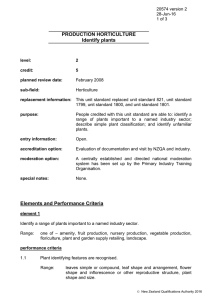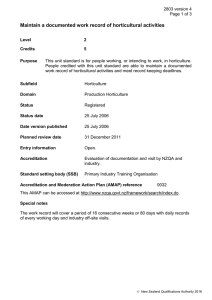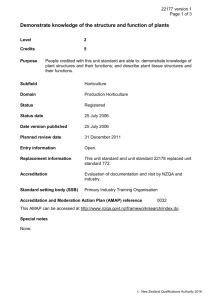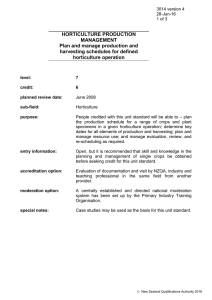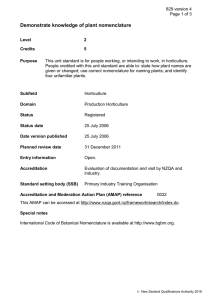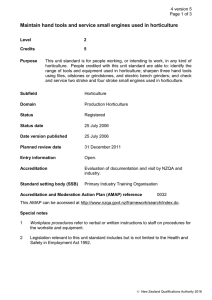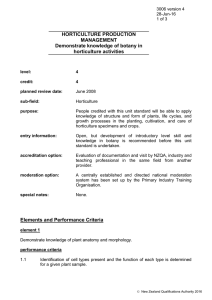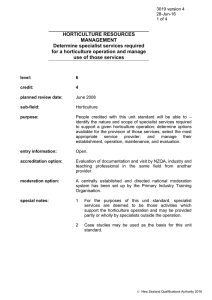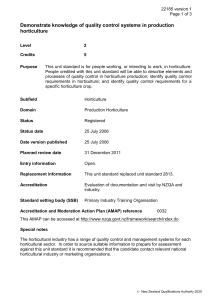Use and maintain specialist horticulture production and harvest equipment
advertisement
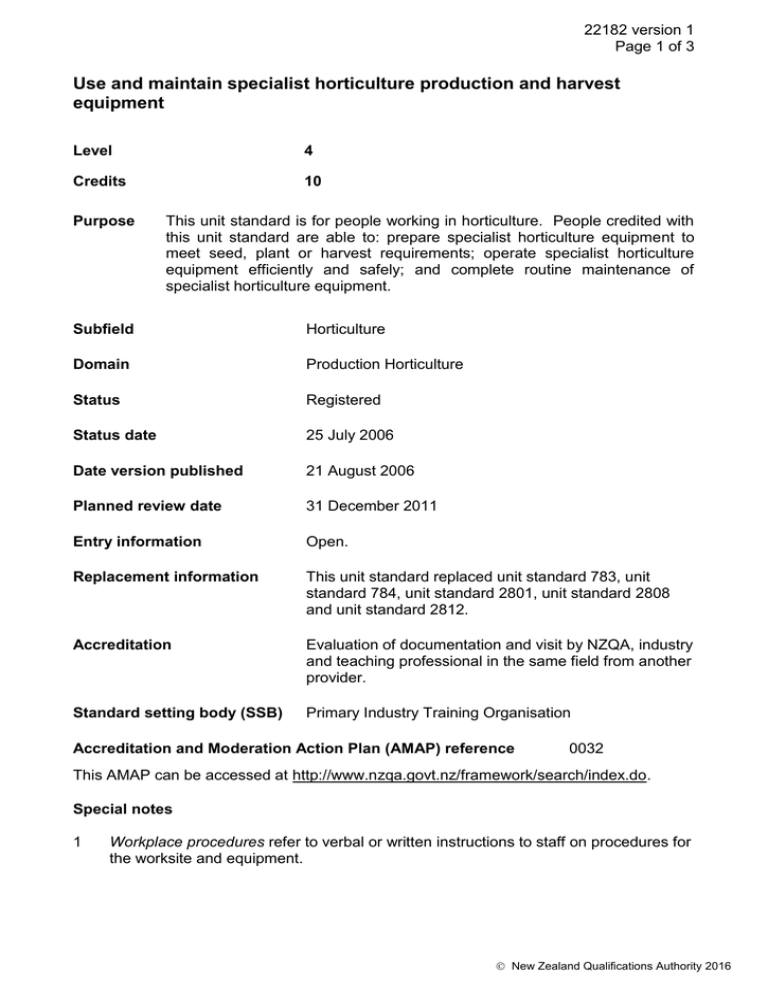
22182 version 1 Page 1 of 3 Use and maintain specialist horticulture production and harvest equipment Level 4 Credits 10 Purpose This unit standard is for people working in horticulture. People credited with this unit standard are able to: prepare specialist horticulture equipment to meet seed, plant or harvest requirements; operate specialist horticulture equipment efficiently and safely; and complete routine maintenance of specialist horticulture equipment. Subfield Horticulture Domain Production Horticulture Status Registered Status date 25 July 2006 Date version published 21 August 2006 Planned review date 31 December 2011 Entry information Open. Replacement information This unit standard replaced unit standard 783, unit standard 784, unit standard 2801, unit standard 2808 and unit standard 2812. Accreditation Evaluation of documentation and visit by NZQA, industry and teaching professional in the same field from another provider. Standard setting body (SSB) Primary Industry Training Organisation Accreditation and Moderation Action Plan (AMAP) reference 0032 This AMAP can be accessed at http://www.nzqa.govt.nz/framework/search/index.do. Special notes 1 Workplace procedures refer to verbal or written instructions to staff on procedures for the worksite and equipment. New Zealand Qualifications Authority 2016 22182 version 1 Page 2 of 3 2 Legislation relevant to this unit standard includes but is not limited to the Hazardous Substances and New Organisms Act 1996 and the Health and Safety in Employment Act 1992. 3 Horticulture production and harvesting equipment could include but is not limited to – belt and chain driven equipment, trailed implement, tractor driven mower, tractor mounted or trailer sprayer, seed drill, fertiliser spreader, harvest grading equipment. 4 A person must be 15 years or older and hold a full light motor vehicle (Class 1) licence to legally drive a tractor up to 4.5 tonne on a public road. 5 Evidence is required for four items of equipment. Elements and performance criteria Element 1 Prepare specialist horticulture equipment to meet seed, plant or harvest requirements. Performance criteria 1.1 Equipment settings are made which meet the crop requirements and conditions. Range 1.2 may include but are not limited to – lubrication, fuel, oil, water, mechanical adjustments, hazards. Adjustments made maximise equipment performance, and respond to changing operating conditions and requirements. Element 2 Operate specialist horticulture equipment efficiently and safely. Performance criteria 2.1 Procedures adopted in the operation of the equipment comply with legislation and are in accordance with the manufacturer's recommendations. 2.2 Equipment is operated according to workplace procedures and crop requirements. Range operation rates, operator techniques, equipment capability range. New Zealand Qualifications Authority 2016 22182 version 1 Page 3 of 3 Element 3 Complete routine maintenance of specialist horticulture equipment. Performance criteria 3.1 Specified maintenance activities are completed as scheduled and as required following inspection of equipment. Range 3.2 may include but are not limited to – lubrication, hydraulics, cleaning, linkages and guards to moving parts, fuel/cooling systems, movement mechanisms. Record of servicing is detailed in maintenance book in accordance with workplace procedures. Please note Providers must be accredited by the Qualifications Authority, or an inter-institutional body with delegated authority for quality assurance, before they can report credits from assessment against unit standards or deliver courses of study leading to that assessment. Industry Training Organisations must be accredited by the Qualifications Authority before they can register credits from assessment against unit standards. Accredited providers and Industry Training Organisations assessing against unit standards must engage with the moderation system that applies to those standards. Accreditation requirements and an outline of the moderation system that applies to this standard are outlined in the Accreditation and Moderation Action Plan (AMAP). The AMAP also includes useful information about special requirements for organisations wishing to develop education and training programmes, such as minimum qualifications for tutors and assessors, and special resource requirements. Comments on this unit standard Please contact the Primary Industry Training Organisation via their website www.primaryito.ac.nz if you wish to suggest changes to the content of this unit standard. New Zealand Qualifications Authority 2016
